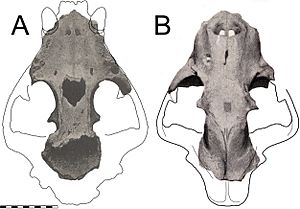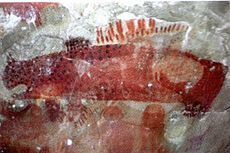Panthera onca mesembrina facts for kids
Quick facts for kids Panthera onca mesembrina |
|
|---|---|
 |
|
| Illustration of the lost holotype skull of Panthera (Felis) onca mesembrina (MLP 10-90). | |
| Scientific classification |
|
| Kingdom: | Animalia |
| Phylum: | Chordata |
| Class: | Mammalia |
| Order: | Carnivora |
| Suborder: | Feliformia |
| Family: | Felidae |
| Subfamily: | Pantherinae |
| Genus: | Panthera |
| Species: | |
| Subspecies: |
P. o. mesembrina
|
| Trinomial name | |
| Panthera onca mesembrina Cabrera, 1934
|
|
| Synonyms | |
|
|
Panthera onca mesembrina was a huge, extinct type of jaguar that lived in southern South America. It roamed the land during the Pleistocene Ice Age, from about 1.8 million to 11,000 years ago. Its bones have mainly been found in Argentina and Chile. Scientists believe it was the largest jaguar subspecies ever known. In 2016, genetic studies showed it was a unique, extinct relative of today's jaguars.
Contents
Discovering the Patagonian Jaguar
In the 1890s, a fossil hunter named Rodolfo Hauthal found some large cat bones in a cave in southern Chile. This cave is known as the "Cueva del Milodon". He sent the bones to Santiago Roth, who thought they belonged to a new type of big cat.
Later, in 1904, Roth found more parts, including skull pieces and even some skin. Then, in 1934, a scientist named Angel Cabrera officially named this big cat Felis onca mesembrina. He used a partial skull found in the same cave as the main example. Sadly, this skull was later lost, and we only have drawings of it.
Over time, more fossils of this jaguar were found. These included bones, teeth, and even ancient poop (called coprolites). They were found in places like Tierra del Fuego in Argentina and other sites in southern Chile. All these fossils show that P. onca mesembrina lived during the late Pleistocene period.
In 2016, a genetic study confirmed that this animal was indeed a unique subspecies of jaguar. However, in 2017, some scientists thought it might be the same as another extinct big cat, Panthera atrox, because they looked similar.
Where Did This Jaguar Live?
Fossils of Panthera onca mesembrina have been found from the very south of Chile, at the "Cueva del Milodon", all the way up to possibly Formosa Province in Argentina. This shows how far north it might have roamed.
In 2021, some fossils found in Cuvieri Cave in Minas Gerais, Brazil were thought to be from P. onca mesembrina. This would be the first time its fossils were found outside Argentina and Chile. This cave has many fossils from different jaguars, including young and old ones. They were found alongside other ancient animals like the giant ground sloth Smilodon populator and Catonyx cuvieri.
What Was the Patagonian Jaguar Like?
How Big Was This Jaguar?
Panthera onca mesembrina was the biggest jaguar subspecies ever! Scientists estimate it weighed around 231 kilograms (about 510 pounds). This is much heavier than any modern jaguar, by as much as 90 kg (nearly 200 pounds). Its size put it in the same league as other huge ancient cats like Smilodon populator (the saber-toothed cat) and the Panthera atrox.
Big cats during the Ice Age were often larger than their modern relatives. This was probably because of the huge prey animals they hunted and the different environment back then. For example, the North American jaguar, Panthera onca augusta, was also much bigger than today's jaguars.
Scientists believe P. onca mesembrina hunted very large animals, weighing around 663 kilograms (about 1,460 pounds). Bite marks found on the bones of giant ground sloths, like Mylodon, prove this.
Skin and Color
In 1904, Santiago Roth described pieces of skin from the face and legs of this jaguar. The face skin was reddish-brown, and the leg skin had a yellowish stripe.
A cave painting found in El Ceibo, Argentina, seems to show this jaguar with a reddish-brown color. This painting helps scientists understand what the animal might have looked like. It was drawn by ancient people alongside pictures of guanacos and humans.
Behavior of the Patagonian Jaguar
Scientists found a healed bite mark on the skull of one Panthera onca mesembrina fossil. This mark was likely caused by another jaguar's canine tooth. In modern jaguars, such marks are usually found on male skulls, suggesting fights or interactions between males. This hints that the fossil might have been from a male jaguar.
At the "Cueva del Milodon" cave, many bones of ancient plant-eaters have been found with tooth and scratch marks that match P. onca mesembrina. These include bones from giant sloths like Mylodon and ancient horses like Hippidion. Most of the bones found were limb bones, which is common when big cats bring food back to their dens.
Scientists also found fossilized poop (coprolites) in the cave that likely belonged to P. onca mesembrina. These coprolites contained tiny bone fragments from Mylodon, showing that the jaguar ate these huge sloths.
Unlike today's jaguars, which mostly live in lush rainforests, the places where P. onca mesembrina fossils have been found in Argentina and Chile were often open and dry. This suggests they lived in different kinds of habitats.
See also
 In Spanish: Jaguar patagónico para niños
In Spanish: Jaguar patagónico para niños
- Panthera onca augusta
- Panthera gombaszoegensis
- South American jaguar



